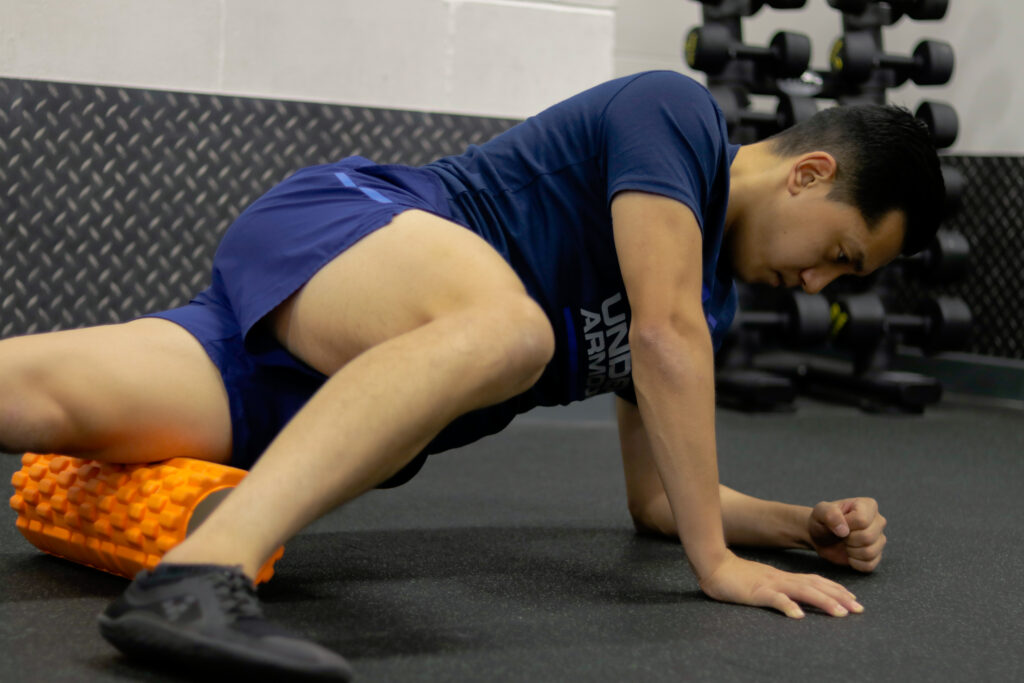FOAM ROLLING
Written by Anmol Rai. 6th March 2020
Editor: Apsana Rai
I am sure most of you have seen people use an odd looking, cylinder shaped foamy tool somewhere in the gym rolling back and forth on it. My friend, that is a Foam Roller. I fell in love with it the day I discovered it and have been using it almost every day since then! Let me tell you why…

History
The tool itself was invented by Moshé Pinchas Feldenkrais, a ukranian-israeli engineer & physicist, but it was his student and a physical therapist, Sean Gallagher who put it on the map in 1987. Over time foam roller’s popularity has risen, however, it was in the late 2000s foam roller became quite prominent and widely accepted in the fitness world. I still remember purchasing my first foam roller in 2014 which I still use till this day! Back then not many people knew of it. Today, from dancers to weightlifters, and pretty much every gym goers to professional athletes are the primary users of a foam roller.
What is a Foam Roller?
Foam roller is a cylinder shaped foam compressed tool that comes in different shapes and sizes but all with the same purpose. Foam rollers these days not only vary in sizes but also in its density, firmness and surface textures. Some companies have even started to make vibrating foam rollers! There are some crazy and unusual ‘foam rollers’ out there…
Foam rolling is a method of ‘self-myofascial release’ (self massage tool) that is mainly used as an aid to improve flexibility, mobility (ROM) and mainly recovery (reduce pain and soreness).

Range of Motion
Foam rolling has proven to show its effectiveness in increasing ROM (range of motion), which is essential to improve mobility and flexibility along with overall performance. In a study that compared vibrating foam roller and a non-vibrating foam roller, usage of both vibrating foam roller and standard foam roller on the quadriceps showed significant increase in knee flexion ROM. This is just one of the many proven studies to back up the claim.
These gains are only temporary but with consistent foam rolling and additional training approaches, you are able to sustain and enhance these gains to help you improve your performance.

Recovery
The most significant effectiveness of foam rolling has shown on reducing pain and muscle soreness (DOMS- Delayed Onset Muscle Soreness) . For this specific purpose, foam rollers are usually used after training or during active recovery sessions along with static stretches. There is plenty of research and studies that have produced strong positive results of reducing soreness and muscle pain.
Although there are lots of studies out there, nothing is better than experiencing it yourself! Go grab a foam roller!

When
This really depends on the individual and what they want to get out of it. You can use it before training to release any muscle tension you may have. With incorporation of right dynamic stretches with foam rolling, you can increase your ROM so you feel prepared for your workout. You can also use it after training during your cool down as it can serve a great purpose to kickstart your recovery.
There is no set time for foam rolling. You can use it anytime you want (or need) to. I try to incorporate it into my daily life as much as I can just because it works wonders for me in alleviating any existing muscles tightness and soreness. I plan to use it after I finish writing this blog!
How to
There are many ways to use a foam roller targeting different muscle groups and areas of the body. You can find many tutorial videos on youtube or you can ask one of the personal trainers in the gym to guide you through.
When foam rolling, remember to relax your muscles and avoid rolling it too fast. This is one of the biggest mistakes I see people make. Also try not to go too hard straight away. During cold weather or environment, make sure to warm up your muscles well before foam rolling for effectivity.
90 SECONDS
Duration
There is no exact time limitation as to how long is optimally effective. However, a latest systematic review in 2019 suggested at least 90 seconds of foam rolling on each muscle group to alleviate muscle soreness. It was also followed by a conclusive result that longer treatment duration can extend the pain-relieving effect. However there are no well grounded results that suggest an optimal duration for ROM. Although from my long years of experience, I can suggest a good few minutes with the correct stretching techniques can suffice (highly dependent on each individual’s case).
What not to
Although foam rolling is generally considered safe, it is important to understand that there are certain things you must avoid, such as foam rolling on seriously injured areas such as sprains, strains and fractures, etc. Also avoid rolling on your joints such as knees, elbows, ankles to prevent them hyperextending and potentially injuring yourself. Always roll different muscle groups separately!
Now you know a little more about foam roller; it’s time to go and get foam rolling!

Reference:
Cheatham SW Stull KR Kolber MJ. Comparison of a vibrating foam roller and a non-vibrating foam roller intervention on knee range of motion and pressure pain threshold: a randomized controlled trial. J Sport Rehabil. 2017.
MacDonald, Graham Z., et al. “Foam rolling as a recovery tool after an intense bout of physical activity.” Medicine & Science in Sports & Exercise 46.1 (2014): 131-142.
Hughes, Garrett A, and Leanne M Ramer. “DURATION OF MYOFASCIAL ROLLING FOR OPTIMAL RECOVERY, RANGE OF MOTION, AND PERFORMANCE: A SYSTEMATIC REVIEW OF THE LITERATURE.” International journal of sports physical therapy vol. 14,6 (2019): 845-859.
Anmol Rai, Kinetic Steps
Personal Trainer & Online coach
Surrey, England, UK.
Phone: (+44) 7525293182
Email: [email protected]
